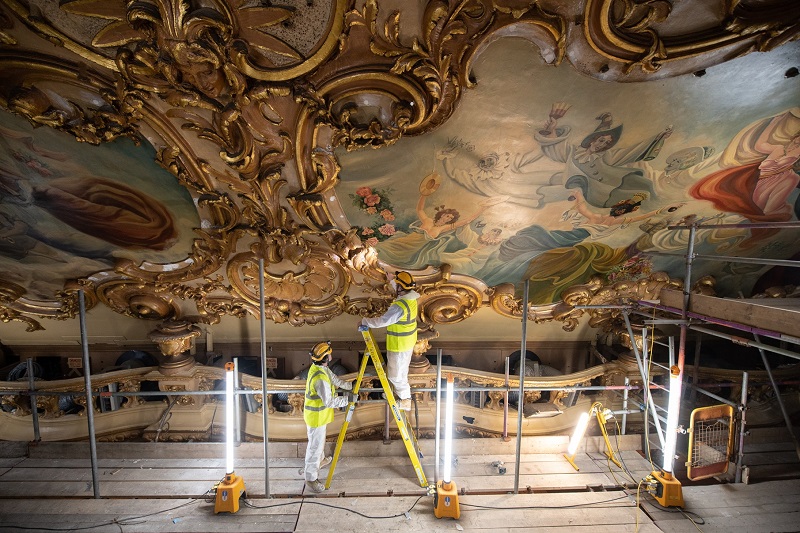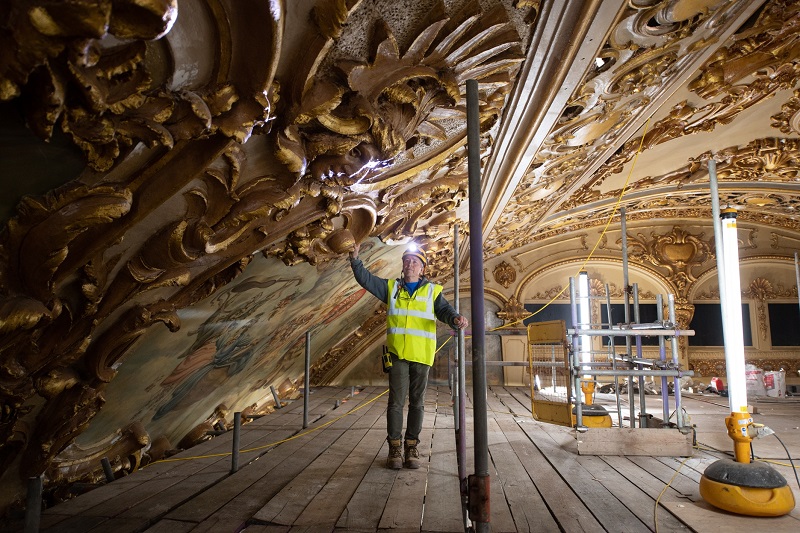Blackpool Tower Ballroom Receives £1.1M Lock-Down Refurbishment
One of the UK’s most iconic buildings is today a step closer to re-opening its doors following a £1.1M refurbishment.

The Blackpool Tower Ballroom, located in the Grade 1 Listed Blackpool Tower, is hoping to re-open on June 21st, providing the Government’s latest road-map out of lockdown goes to plan.
The venue, which dates back to 1894 and is known by millions as the home to Strictly Come Dancing’s annual ballroom special, has under-gone the most extensive programme of work and deep clean for more than 60 years.
A team, including some of the most highly skilled craftsmen in the country, who have worked across the world on projects including the Queen’s Gallery at Buckingham Palace, have dedicated more than 21,000 hours, over a period of six months, each climbing an average of 85 flights of scaffolding daily, to restore the famous Blackpool Tower Ballroom to its original glory.
The team has discovered signatures under the murals that adorn the ornate plasterwork ceiling showing the last time anyone was in this space was in 1957! These historic works took place following a fire in the building which caused severe damage to the ballroom. At the time, these works were estimated to cost over half a million pounds and took 17 months to complete.
The work has been made possible thanks to a lifeline grant of £764,000 as part of the Government’s unprecedented £1.57 billion Culture Recovery Fund, together with funding from Blackpool Council, taking the total investment to £1.1M.

The grant, awarded to Blackpool Council by Historic England, has supported the venue to carry out comprehensive repair and restoration work on the ballroom’s period plasterwork ceiling.
It is one of the most “significant” projects Historic England has been involved with to date and has replicated the skills used by workers back in 1894 when the Tower was built, including:
· Skilled scaffolders, artists, decorators, structural engineers, joiners, plasters and conservators all pooling their skills.
· The rare art of fibrous plastering
· More than two tonnes of plaster being mixed.
· Organic hessian being imported from India to mix with the plaster to make a special formula allowing intricate repairs to be carried out to the ornate plaster work adorning the ballroom ceiling.
· A team of over 30 specialists on site, working a combined 21,000 hours.
· Skilled craftspeople working daily in tiny roof spaces to inspect and restore the ornate plasterwork from behind the ceiling.
· Oil paints being colour-matched by the naked eye by on site restoration experts to patch up murals damaged by water ingress and nicotine over the years.
· Several hundred litres of gold paint being mixed to ensure the gold leaf ornate artwork is restored to its former glory.
· Deep cleaning behind all of the ornate models which adorn the ceiling, with dozens of dust filled bags being removed from site every day.
· Murals being deep cleaned removing water damage and nicotine damage from over the decades.
· Intricate and detailed research work being carried out to establish exactly how the work was originally done to ensure all the works which took place during this latest refurbishment were carried out to the exact same standards. This involved drilling more than 12 square spaces in the roof space to enable this “methodology” as the craftspeople call it to be carried out.
The work, led by Hayles and Howe, specialists in ornamental plaster work and scagliola, has also uncovered some incredibly rare and unusual finds – all discovered in the angel figures adorning the ballroom ceiling.
These have included newspapers dating back to 1911, old cigarette packs which would be museum pieces today and even an old walking stick, believed to date back to the early fifties.
Keith Langton, project manager, said: “I thought Buckingham Palace had the wow factor – which obviously it absolutely did.
“But working here at The Blackpool Tower Ballroom has literally blown me away. This really is something else. It is a project I will never forget – and perhaps even a project for me to retire on. Everyone wants to end their career on a high – and I don’t think I could get a better high than working at the Ballroom.
“It has been an absolute pleasure and honour!”
He has, however, warned of the desperate need to recruit more young craftspeople into what he describes as a “rare trade.”
Keith added: “We are just not seeing enough young people coming through.
“Fibrous plastering – the key trade being used on the refurbishment – is becoming a rare trade and we just cannot allow this to happen.
“Without people being skilled in this way, buildings like this would be forced to close. It is essential more young people take up careers in this sector. Literally everywhere I go, in this country and abroad, I make it a priority to pass on as many skills as possible to as many people as possible – hopefully inspiring them all along the way!”
This the longest period of time in its history the ballroom has been closed, with the exception of the fire in 1956/7.
Historic England has worked closely with the expert team leading the work on site.
Tamsin Cooke, Heritage at Risk Projects Officer at Historic England, said: “It really is incredible to see the work which has gone on here – which is exactly as it would have been carried out when the ballroom was built all those years ago, those traditional methods are still being used today! This is a very historical moment for Blackpool.
“This is an extremely rare and precious building. Only one in 40 Listed Buildings are given Grade 1 Listed status.
“Blackpool is a real icon of British seaside. And the ballroom is a real jewel in Blackpool’s crown!
“The Culture Recovery Fund grant awarded by Historic England for the repair work has been a great opportunity. This is a huge grant for Historic England to award but we are extremely excited about the opportunity to make a difference to such a well-known and well-loved location – not just for today’s visitors – but for generations to come.
“It is so important to preserve buildings such as this and a ballroom which dancers and families world-wide enjoy so much!”
Councillor Gillian Campbell, Cabinet Member for Tourism & Culture, at Blackpool Council, added: “We are thrilled to be awarded this grant which will help bring the ornate ceiling of the magnificent Tower Ballroom back to its former glory. The ballroom has provided entertainment for generations of people for more than a century and is a national treasure, not least because of its relationship with Strictly.
“We are enormously appreciative that its importance to the cultural heritage of this country has been recognised in this way.”
Kenny Mew, General Manager of The Blackpool Tower, said he cannot wait to re-open the ballroom.
He added: “The works which have been carried out really are something very special. This is a once in a lifetime project that I feel incredibly fortunate to have been involved in.
“We cannot wait to reopen our doors and invite the public to experience the splendour of The Blackpool Tower Ballroom first hand, whether they are taking to the dancefloor, enjoying afternoon tea or simply taking in the incredible surroundings.
“Due to the Coronavirus pandemic the ballroom has now been closed for over 12 months, we are hoping to re-open on June 21st, if the Government’s continued road map out of lockdown goes to plan!”
Culture Minister Caroline Dinenage added: “The Blackpool Tower Ballroom has been at the heart of British dance for more than a century, annually hosting the Strictly Come Dancing Blackpool special.
“I am delighted that, thanks to the Culture Recovery Fund, the ballroom has been fully restored and is getting ready to reopen and host fantastic dances and events once more.”
Robin Harrison, Managing Director at Hayles and Howe, added: “The Blackpool Tower project has been one of the most challenging projects we have undertaken.
“It has allowed us to continue to learn and develop our methodologies to restore historic plasterwork.
“This project is a very iconic one for both myself and my team and is definitely one of our flagship pieces of work. One of my favourite parts of looking after buildings like this is being able to give something back to the public to enjoy safely for generations to come.”